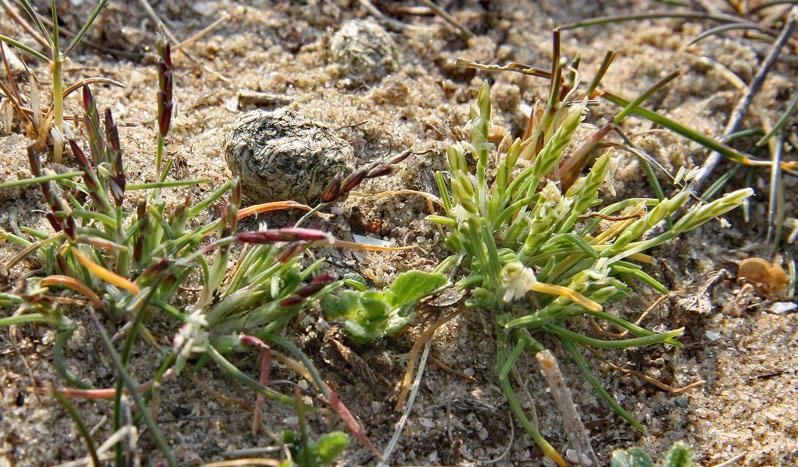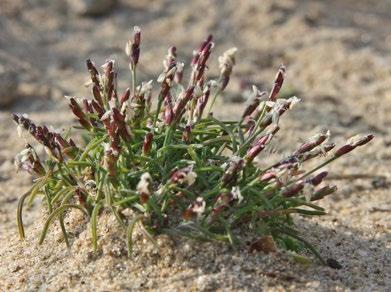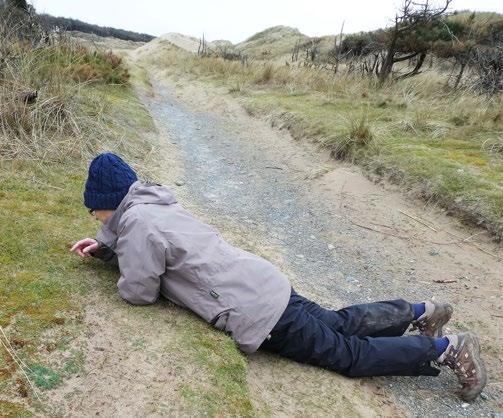
14 minute read
Native status and Mibora minima (Early Sand- grass) James Robertson
JAMES ROBERTSON
Advertisement
Iwas intrigued to read about a second site for Ireland of Mibora minima (Early Sand-grass) in BSBI News 146 (Lyons, 2021). Mibora and I became neighbours when I moved to Anglesey three decades ago, but I was already interested in this tiny but attractive grass. It flowers before spring has truly arrived; the dazzle of its silver and purple spikelets and rigid posture belie its ‘minimal’ nomenclature. Anglesey is arguably its only native mainland location, and I take pride in this. But is it truly native and what does this term mean in these newly-formed inter-glacial islands in which human and natural history are so substantially woven together?
I first encountered Mibora minima in 1983 with the then BSBI Hon Meetings secretary, Joanna Martin. It was growing abundantly on bare sandy ground in a nursery at West End in Surrey. It was also in an adjacent garden, formerly part of the nursery, a dense carpet in full flower in March where turf had been lifted to establish a soft fruit bed. There are old records from two nearby Surrey nurseries (Lousley, 1976). At the time it was well established at other sandy sites in Hampshire, and BSBI’s online Atlas
Dark and pale forms of Mibora minima (Early Sandgrass) at Aberffraw Dunes. Jane Rees
of the British and Irish Flora notes that it is recorded inland as a casual plant in nurseries and gardens.
Some years later I learned of its honoured status as a rare native plant on Anglesey. The first record for Mibora minima is in Hudson’s Flora Anglica (1762), written under the auspices of Benjamin Stillingfleet, who provided the record, but without a named location. Since it was recorded as Knappia in Welsh Botanology (1813), mainly at the outlet of Llyn Coron, at the edge of Aberffraw sand dunes, but also at Tywyn Trewan to the north, its native status on Anglesey has never been in doubt. There is no evidence that Stillingfleet ever visited Anglesey, although there were a number of prominent naturalists active on Anglesey in the late 18th century. I will come to one of these, William Morris, later.
Griffiths (1895) describes it as ‘native; on dry, sandy pastures. Rare.’ He notes two locations: on Aberffraw Common and near Maelog Lake
Hotel. Both of these are along Anglesey’s southwest, sand-dune enriched coast, as are all its current populations. Anglesey’s Rare Plant Register (Bonner, 2006) lists about 20 extant sites, which are all more or less subdivisions of those given by Griffiths, noting also the decline near Newborough. It is currently known from 23 monads between Cymeran, across the strait from Holy Island, and Newborough, a substantial distance, for which all but five are post2000 records. Although the number of plants may run into thousands, for example on Aberffraw sand dunes, it is extremely local within this area and absent from swathes of apparently suitable dry but winter-damp sand.
Mibora minima has a restricted natural global distribution in south-west and southern Europe, including Portugal and western France, and northwest Africa, but it has been a successful global traveller. It has colonised a substantial area on the border between Canada and USA, where it has been described as an invasive alien, and has been recorded in Western Australia and South Island, New Zealand. In Europe it is widely naturalised, with a disjunct population in Ukraine. It may have spread to some of its scattered inland locations as an early introduction, over a period of several millennia, taking advantage of continuous and growing human traffic from southern Europe northwards. It also grows on the Channel Isles: on Jersey, for example on a sloping hillside with open vegetation at Quernevais; on Guernsey, for example abundantly on dry slopes at Pleinmont Headland; and on Herm. These locations are undoubtedly native and fit with its other native locations in south-west Europe. It is interesting that the habitat is somewhat different from the dry but winter-damp sandy sites on Anglesey.
In 1964 Mibora minima was found on sandy turf at Whiteford Burrows, Gower (v.c.41) where it was considered to be native (Cope & Gray, 2009). This assumption was made in the absence of evidence to the contrary. Currently there are 36 records for Mibora minima at Whiteford on the BSBI database, at different scales and overlapping localities. The status was entered as unknown for 23 of these, native for 11 and casual (present briefly – less than five years) for 2. Only once, in 1988, was a population described as abundant, with thousands of plants. Very small numbers are recorded for all but one of the nine post-2000 records. A substantial area of sand dunes at Whiteford was planted with conifers between 1955 and 1964. Young trees provide a possible route for plant introductions on sand dunes; for example the spread of Round-leaved Wintergreen (Pyrola rotundifolia), first recorded on the dunes at Newborough Warren NNR in 1955, coincides with the planting of Corsican Pine (Pinus nigra) in the 1950s.
In 1993 Mibora minima turned up on Studland Heath NNR, Dorset, where it is thought to be an introduction. It has also been recorded as an alien in Suffolk and in 1996 it was discovered on relict sand dunes on the Sefton Coast (Smith et al., 2011) in v.c.59. There, the area colonised by it was monitored and mapped in 1999 and 2004 (Smith, 2005) during which time the area it occupied had increased by almost 50%. This points to a relatively recent introduction. It has been suggested (Preston et al., 2002) that it is most likely to be the result of spread from the native sites in Wales. The authors add that it is almost impossible to say whether several new populations discovered since 1980 are native or alien. A further population of over 1,000
Mibora minima (Early Sand-grass) at Aberffraw Dunes. Jane Rees

Mibora searcher at Newborough Warren. Ivor Rees
plants across two hectads was discovered in 2015 on North Uist (Smith et al.,2015). Here the authors consider that ‘on balance it is perhaps most likely to be native’. Previous records in Scotland, believed to be deliberate introductions in the Aberlady Bay area in East Lothian, date back to 1851.
The first record in Ireland was made in 2005 (O’Mahony, 2009) where it was found at Barley Cove, by Mizen Head in far West Cork. Its discoverer, Tony O’Mahony, considers it to be a native which has been overlooked because of its small stature, early flowering and the inhospitable nature of the terrain. However he also points out that it is a distinctive little grass, and he estimated the population at approximately 100,000 plants.
The discovery in 2020 of this tiny grass on North Bull Island, Dublin (Lyons, 2021) adds a further twist to the ‘native or alien’ dichotomy. Its author, Mandy Lyons, gives it the status of native, but makes the fair comment that ‘the route by which this species might have reached the island and whether human activity – unwitting or otherwise – played a part in its arrival is unknown’. Acceptance of the Cork population as native is taken to support the idea that the newly discovered population is also native. The difficulty with this is that, as the author points out, North Bull Island is relatively young, having been formed within the last 200 years. Captain Bligh of Mutiny on the Bounty fame drew up plans for breakwaters to channel tidal flows in order to scour and deepen the channel through the sand bar to facilitate access by boats up the river Liffey to the Port of Dublin. North Bull Wall was completed in 1825 but it took many decades before North Bull Island was formed from accreting sand. It might also be significant that the location of the discovery is close to a roundabout and environmental centre. Transport links between Anglesey and Dublin have been greatly improved in recent years, notably after the introduction of roll-on roll-off ferries to and from Dublin Port. Ivor Rees (pers. com.) speculates that camper vans are often present close to Mibora minima populations on Anglesey; some of these then cross the Irish Sea, and may stop off at North Bull Island. Seed could be transported in this way.
The status of Mibora minima as a native on Anglesey depends on its appearance in Welsh Botanology (Davies, 1813). This gives it more than two centuries of provenance. Despite the absence of early records from any other coastal sites, this is taken as evidence of its true native status on Anglesey: a species which arrived under its own steam at some time in the post-glacial period. The opportunity for such natural colonisation would be greater had there been reasonably close refugia where the species could have persisted until the end of the last glaciation; and if its distribution were continuous or connected enough to indicate how

a slow-spreading species had reached its current locations. Neither of these pertains, so it is worth considering other possibilities.
There are many ways in which Mibora minima could have been transported from its native sites outside England and Wales, such as in the Channel Isles, to its main ‘native’ station on Anglesey. Here I explore just one of these, the horticultural trade, which indicates the extent of human transportation of plants and soils over several centuries. William Morris (1705–1763), a formidable letter-writer, along with his brothers, was a keen gardener, botanist and naturalist (Ramage, 1987). He was Controller of His Majesty’s Customs, Holyhead, and constructed a residence on Holy Island. From his letters we know that there was a brisk trade in shrubs and plants between nurseries in the south of England, the Channel Isles (he mentions Guernsey Lily in manuscript notes) and Anglesey. There was much exchanging of plants between gardeners in those counties in southern England where Mibora minima has been recorded. The nursery where I first encountered it belonged to the rose specialist Henry Street, and there were many other nurseries on Hampshire and Surrey sands which grew shrubs for export around the country.
Morris also received many exotic seeds and plants from sea captains who dealt with him as Customs Controller. He made a catalogue of all the plants in and around Holyhead although did not find Mibora minima. Hugh Davies (1739–1812) described Morris as ‘an ingenious and skilful naturalist’ and used his plant catalogue as a source for Welsh Botanology (Davies, 1813).
The late 17th century saw an upsurge in the construction or reconstruction of large houses and gardens, such as Bodorgan Hall (1779–82). Aberffaw Common lies close to Bodorgan Hall and belongs to the Bodorgan estate to this day. This extensive area of dunes includes 6 of 20 listed locations for Mibora minima (Bonner, 2006). Here it is numerous and extensive, looks natural and these dunes are exceptionally plant-rich. Genetic variation is not as great as in plants on Guernsey but it is not ‘in-bred’ (John et al., 1989). On the other hand, it favours a relatively transient habitat with much bare sand, accompanied by other pioneer annuals such as Sea Mouse-ear Cerastium diffusum; and its populations are usually close to estate roads or beside long established footpaths. The same picture is true of most of the other locations. These dunes have, or have had, large rabbit populations, which provide the disturbance which the grass exploits. (In nurseries humans provide the required disturbance.) Efforts to split the species into two possible subspecies or forms (minima and littorea) do not work well with Anglesey plants (Jones, 2005), which are generally intermediate. Michael Wilcox is currently looking at these two forms and this could shed light on the origin of the Anglesey population (see article, p.15). By contrast it is easy to spot the two colour forms, one bright greenish yellow, and a darker one with reddish-bronze spikes.
Whether or not a plant is considered native gains importance when prioritising conservation efforts, although it is generally much better to focus action on habitats rather than on individual rare species. When I set out evidence to suggest that Deptford Pink (Dianthus armeria)was probably an introduction in these islands, spread by humans (Robertson, 2016), there was a reaction from those engaged in conservation efforts for this species, who felt that my arguments undermined their work and the plant’s standing as a protected species. Deptford Pink was discovered for the first time in Ireland in 1993 on Horse Island, Co Cork, but Tony O’Mahony is doubtful about its native status (O’Mahony, 2009). Deptford Pink is an international traveller, widespread as a result of accidental translocations, and this facility is also a factor to consider in the case of Mibora minima.
A binary view of plants as being either native, which means they arrived here long ago by natural means, or non-native, everything else, encourages botanists to seek to categorise much-loved plants (axiophtes) as native. Yet their cultural context offers another rich vein of value and interest. Conservation looks for support to both science and culture.
More evidence will no doubt come to light (for example from post-glacial pollen analysis) to defuse
doubts about the native status of some species. David Pearman (pers. comm.) has pointed out that one of the criteria for the new Atlas of the British Flora accords native status to species ‘on the grounds that they are accidentally dispersed from a native site by foot or vehicle, which is a natural colonisation’. These are difficult grounds, because once you decide that a site is native because plants have colonised it through accidental human dispersal, plants dispersed from that site to new locations can be given native status. There is also the problem of ascribing human intentions to the dispersal. We are some way from acceptance of such a definition, even though it would seem sensible to accord native status to long-term colonists. After all, nature is not static, and time does not stand still. Species which have reached our shores via human activities at some point in the distant past, and have established themselves here, occupy an environment which is substantially different from the one that greeted the early post-glacial arrivals. Sea level changes have contributed to the reshaping of our coasts and sand dunes, the climate has altered and changing patterns of disturbance have created new opportunities for plants.
We cannot be sure of the exact status of Mibora minima but it was almost certainly not in the first wave of post-glacial spread; it may not be strictly ‘native’ outside the Channel Isles. But it is a long way from deserving the somewhat pejorative term ‘alien’. Several attempts have been made to soften existing plant categories (Walker et al., 2019). Extending the definition of ‘native’ to embrace long-established plants which are well-integrated into the flora and behave as natives would be one way to go. As for conservation priorities, it is much better to emphasise the value of plant communities which are essentially natural in character, and conserve these. They may include occasional additions made over time as a result of the incessant activities of our species. These additions add another layer of interest to our flora, drawing together the threads of human and natural history.
Acknowledgements
My thanks go to Ian Bonner, Nigel Brown, David Pearman and Ivor Rees for advice and help with this paper.
References
Bonner, I. 2006. Anglesey Rare Plant Register. Cope, T. & Gray, A. 2009. Grasses of the British Isles, BSBI
Handbook No. 13. Botanical Society of the British Isles,
London. Davies, H. 1813. Welsh Botanology. London. Griffith, J.E. 1895. Flora of Anglesey & Carnarvonshire. Bangor. John, M.R., & Kay, Q.O.N. 1989. Population structure and inter-relationships in a rare British annual grass: Mibora minima. BSBI News 51: 49. Jones, A. 2005. Lusitanian affinities in Welsh Early Sandgrass? BSBI Welsh Bulletin 76: 16. Lousely, J.E. 1976. Flora of Surrey. David and Charles. Lyons, M. 2021. Mibora minima (Early Sand-grass) on North
Bull Island, Dublin – second record for Ireland. BSBI
News 146: 17–20. O’Mahony, T., 2009. Wildflowers of Cork City and County. The
Collins Press. Preston, C.D., Pearman, D.A. & Dines, T.D. (eds) 2002. New
Atlas of the British and Irish Flora. Oxford University Press,
Oxford. Ramage, H. 1987. Portrait of an Island. Anglesey Antiquarian
Society. Robertson, J. 2016. A Study in Pink. British Wildlife 27: 154–160. Smith, P.A., Prescott, O. & Bungard, J. 2015. Mibora minima in the north-west of Scotland, on Baleshare Island, North
Uist (v.c.110). BSBI News 130: 26–27. Smith, P.H., Caulfield, C.M., & Lockwood, P.A. 2011.
Changing status of Mibora minima on the Sefton Coast.
BSBI News 118: 28–32. Smith, P.H. 2005. Mibora minima on the Sefton Coast,
Merseyside. BSBI News 99: 33–34. Walker, K.J., Leach, S.J., Preston, C.D., Humphrey, T.A.,
James, T.J., Pearman, D.A., & Smith, P.A. 2019. Recording plant status and regeneration during single visits. British & Irish Botany 1: 283–291.
James Robertson
Tyddyn Adda, Llanddaniel, Anglesey LL60 6HB










